François-Antoine Jecker, 1765 - 1834
Jecker Frères, ca. 1806 - 1837
Jecker Fils, 1837 - ca. 1846
by Brian Stevenson
last updated October, 2022
His contemporaries credited François-Antoine Jecker with establishing the manufacture of precision engineering and optical instruments in France. Through most of the 1700s, English manufacturers led the world in quality. This meant that the French had to acquire instruments for military and scientific use from their rival country, at very high prices. This ended after Jecker served for six years with Jesse Ramsden (1735-1800), one of London’s pre-eminent producers of mathematical and optical instruments. He returned to France in 1792, and set up a business in Paris that followed Ramsden’s model.
Jecker’s microscopes possess unique characteristics, combining traditional styles with innovative features (Figures 1-3). While his microscopes are rather uncommon now, Jecker’s engineering instruments and telescopes appear frequently at auctions. His coin scales (Figure 4) are rather common, a consequence of his having manufactured over 80,000 of them.
Jecker apparently managed his business alone until around 1806, when he was joined by one or more brother, forming “Jecker Frères”. That name remained in use until 1837, when the business was evidently taken over by one or more son, and operated as “Jecker Fils”. The business appears to have ended during the mid-1840s. To the best of my knowledge, all of their instruments are marked simply “Jecker”.
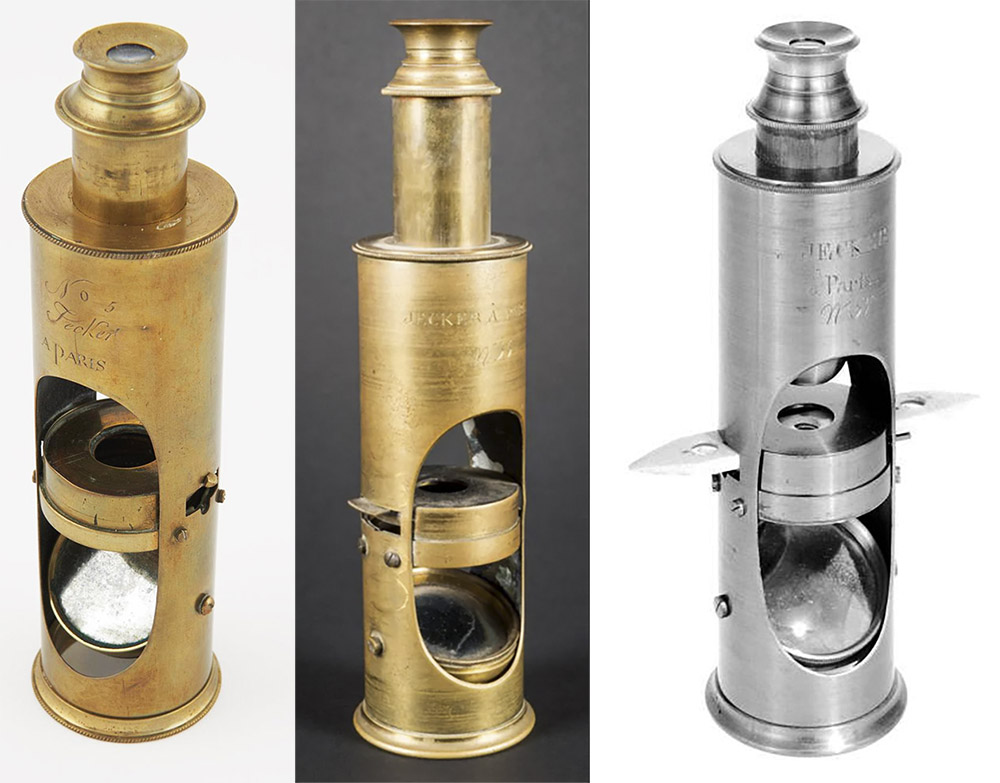
Figure 1.
Three drum microscopes by François-Antoine Jecker. The left bears the number 5, center has number 55, and the right has number 57. Adapted for nonprofit, educational purposes from (left to right) https://collection.sciencemuseum.org.uk/objects/co118204/drum-microscope-by-secker-of-paris-1801-1850-drum-microscopes, an internet auction site, and http://waywiser.fas.harvard.edu/objects/15772/drum-compound-microscope. The left microscope is misidentified on the Science Museum Group’s web site as being by “Secker”.
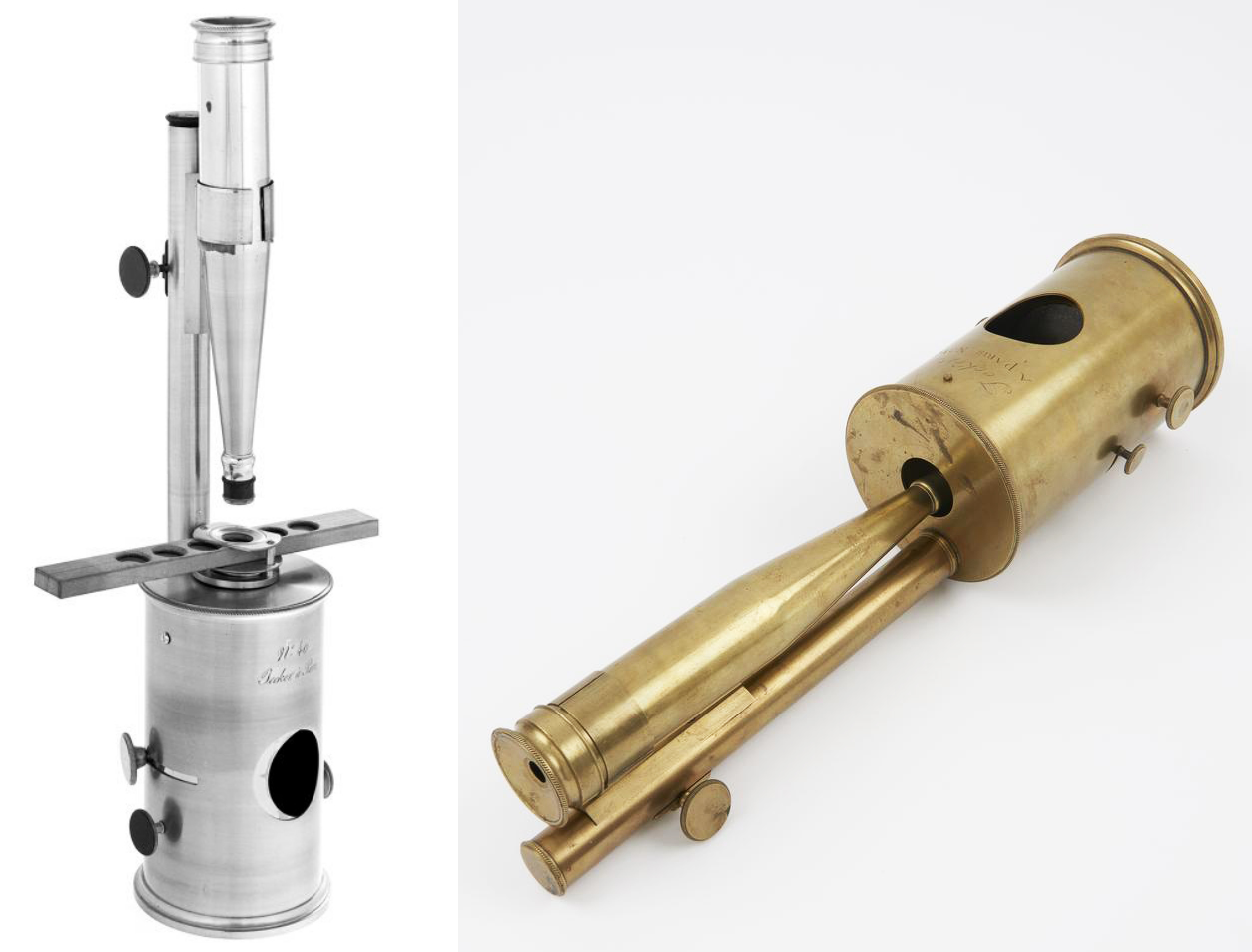
Figure 2.
Two examples of a unique microscope design, with a cylindrical drum-style base, and a separate, narrow, compound body tube. The microscope on the left bears the number 40. Adapted for nonprofit, educational purposes from http://waywiser.fas.harvard.edu/objects/15678/drum-compound-microscope and http://collection.sciencemuseum.org.uk/objects/co8658/microscope-by-jecker-a-paris-1810-1820.
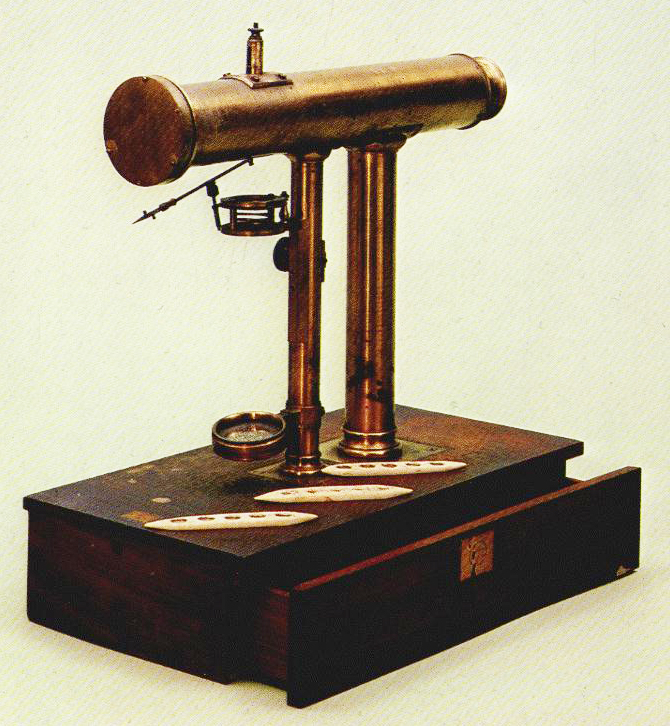
Figure 3.
A horizontal microscope by Jecker, in which magnification is produced by a concave mirror above the stage. That method was popularized during the 1810s by Giovanni Amici (1786-1863). An 1826 description of the Jecker firm mentioned a “microscope à réflexion”, which was undoubtedly this type of instrument. Adapted for nonprofit, educational purposes from an image of the microscope at the University of Naples, Italy, http://jedlik.phy.bme.hu/~hartlein/Museum/Museum-old/Optics-5.html.

Figure 4.
A small, folding balance by Jecker, produced for determining the weight of coins. Jecker’s firm reportedly produced 80,000 of these instruments. Adapted for nonprofit, educational purposes from an internet auction site.
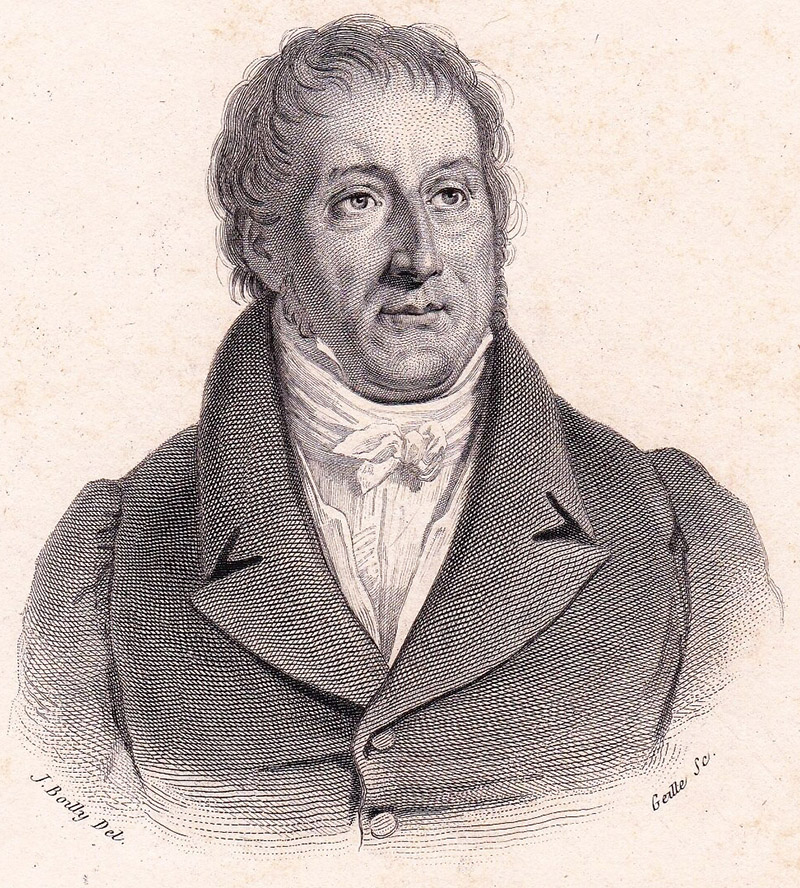
Figure 5.
François-Antoine Jecker, from “Portraits et Histoire des Hommes Utiles”, 1837.
The majority of knowledge about François-Antoine Jecker’s life comes from Arthur Barker’s biography, which was published in the 1837 Portraits et Histoire des Hommes Utiles.
Jecker was born on November 14, 1765, in Hirtzfelden, Haut-Rhin, Alsace, France. His father was a farmer, but François-Antoine developed an affinity for the mechanical arts. Whenever possible, he read scientific books and built machines of his own devising. When he was nineteen, François-Antoine was given permission live with two musician uncles in the substantially larger city of Besançon. He there became apprenticed to a machinist. Within a year, Jecker knew as much as his master.
He thought of moving to Paris but, realizing that France was inferior to England for all branches of mechanics, he instead moved to London. In 1786, Jecker began an apprenticeship with Ramsden. Barker reported that Jecker and Ramsden soon became friends, and remained so for life.
Jecker returned to France in 1792, and began a business in Paris. Shortly afterward, he was drafted into the army, and rose to the rank of Captain. He left that post as soon as possible, to fulfill his dream of establishing a precision machine works. As Barker wrote, “Il organise sur une vaste échelle, dans un des quartiers populeux de la capitale, une fabrique d'instrumens d'astronomie, de géodésie et d'optique. Il enseigne à une classe nombreuse d'ouvriers, dont il devient le bienfaiteur et le père, l'art tout nouveau pour nos mécaniciens français de fabriquer des instrumens de précision. Sous ses ordres s'exécutent successivement plusieurs machines dont la rare perfection excite l'admiration des hommes de l'art” (He organized a large factory in a populous district of the capital, making astronomical, geodesic, and optical instruments. in one of the populous districts of the capital. He taught large numbers of workers in the new arts of manufacturing precision instruments, and became their benefactor and guardian. Machines built under his orders are of rare perfection, and are greatly admired).
The 1798 Almanach du Commerce de Paris listed Jecker at 4 Rue de la Vieille-Draperie. By the next year, he had moved to 42 Rue des Marmousets. He earned a Bronze Medal at the 1801 French industrial exhibition, and a Silver Medal at the 1802 exhibition.
By 1806, the business had become “Jecker Fères”, operating from 10 Rue des Deux-Portes. Neither the reason for this partnership nor the identity(ies) of the brother(s) are mentioned in biographies of Jecker. However, government records indicate that children of Laurent Jecker married in 1821 and in 1828, who had home addresses that were the same as the Jecker Fréres business. The 1821 marriage record of son César noted that father Laurent was then deceased. Some modern sources suggest that there was a third brother whose name began with an “A”, due to some old records of “A. Jecker”, although I think it likely that those actually refer to François-Antoine.
Other government records indicate that François-Antoine Jecker was married to Antoinette Boussod. They had at least two children: Marie Elisabeth, who married on June 4, 1825, and Pauline, who married on March 12, 1827.
Around 1810, the business moved to 32 Rue de Bondy (also spelled Bondi). An 1812 description of Jecker’s products noted that their instruments were comparable to, or exceeded in quality, those of England. Moreover, they sold for thirty per cent less than English instruments.
The business address shifted slightly in about 1830, to 48 Rue de Bondy.
François-Antoine Jecker died on September 30, 1834, of “congestion cérébrale”. He was sixty-nine years old
The firm continued as Jecker Fréres until 1837, when it was renamed Jecker Fils. I did not find any records of the owners after François-Antoine Jecker’s death. As noted above, his probable brother, Laurent, died before 1821. A possible owner is Laurent’s son, César Emmanuel Victor Jecker, whose 1821 marriage record described his occupation as “mechanician”. Another possibility is Laurent’s son-in-law, Chrétien Frédéric Lehnert, who died in 1840 at 48 Rue de Bondy, the Jecker business address. The latest record I found of the Jecker business was their 1846 entry in the Annuaire Général.

Figure 6.
Description of the Jecker Fréres business, from the 1815 “Almanach du Commerce de Paris”.

Figure 7.
An 1826 description of the Jecker business, from “Bazar Parisien”. The “microscope à réflexion” was probably a reflecting microscope such as shown above in Figure 3.
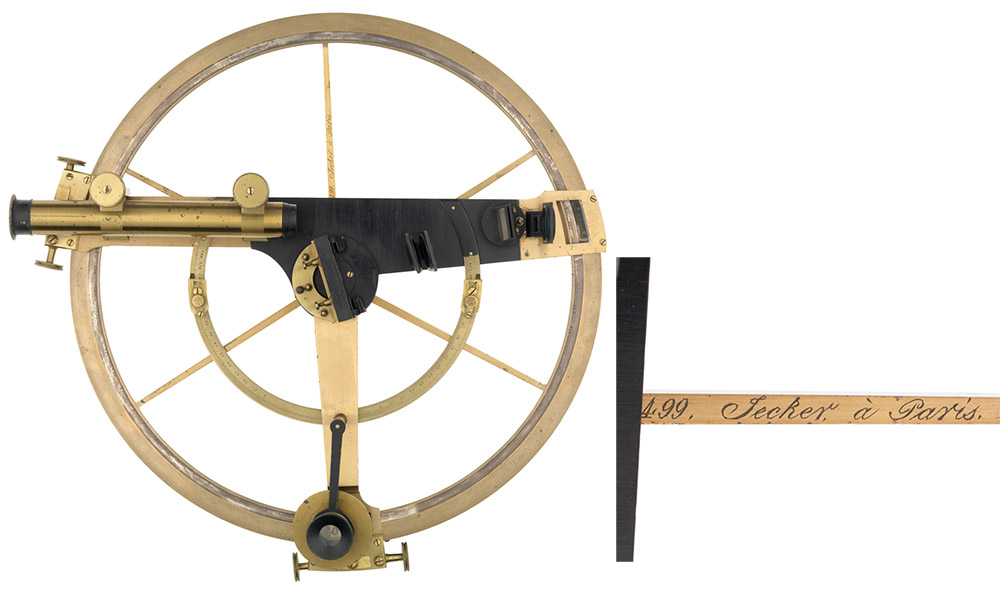
Figure 8.
A repeating circle (“Borda circle”) by Jecker. Adapted for nonprofit, educational purposes from https://collections.rmg.co.uk/collections/objects/42284.html.

Figure 9.
A folding ruler by Jecker. Adapted for nonprofit, educational purposes from an internet retail site.

Figure 10.
A military range-finder by Jecker. Adapted for nonprofit, educational purposes from an internet retail site.
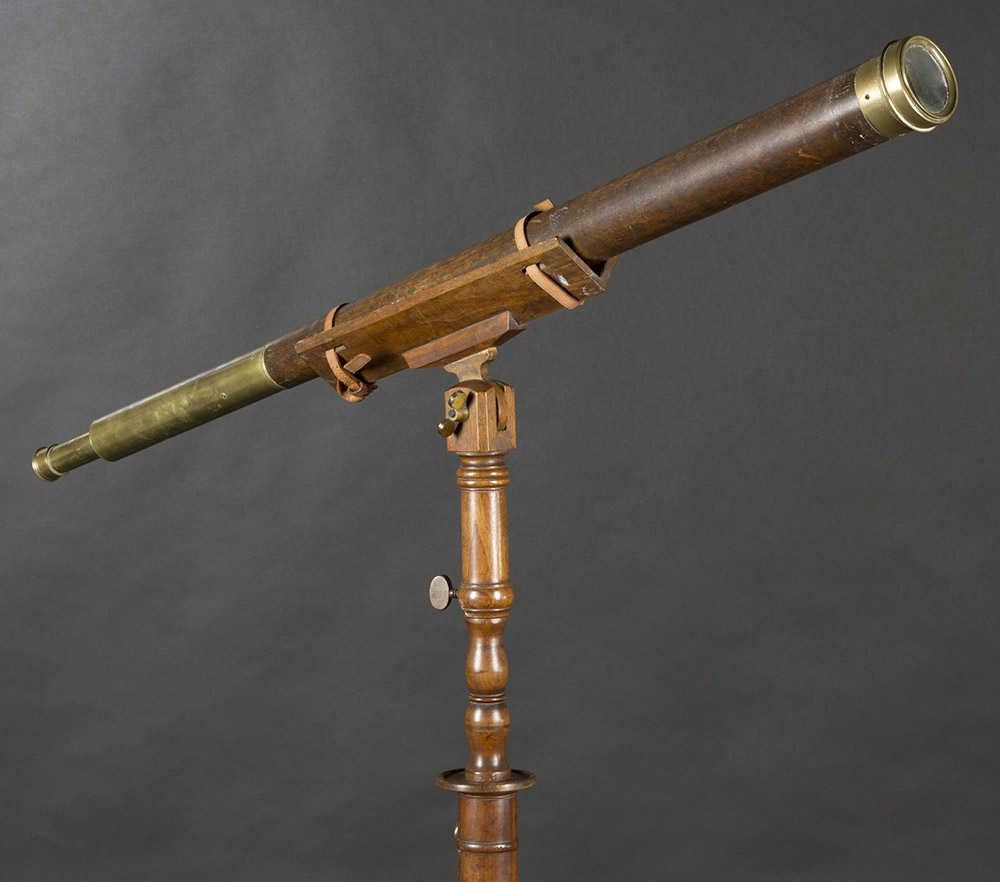
Figure 11.
A Jecker telescope. Adapted for nonprofit, educational purposes from an internet retail site.

Figure 12.
Two monocular opera glasses by Jecker. Adapted for nonprofit, educational purposes from (left) an internet auction site and (right) http://fp.optics.arizona.edu/antiques/Telescope/Catalogue/B05/B05.htm.

Figure 13.
A walking cane with built-in telescope, manufactured by Jecker. Adapted for nonprofit, educational purposes from an internet auction site.
Resources
Almanach des 25000 Addresses des Principaux Habitans de Paris (1832) “Jecker frères, optic. et mécan. pour la marine, r. Bondi 48 … Jecker aîné (de la maison ci-dessus), prop., élig., r. de Bondi 48”, page 305
Almanach du Commerce de Paris (1798) “Jecker, rue de la Vieille-Draperie, no. 4 - de la Cit鈔, page 314
Almanach du Commerce de Paris (1799) “Jecker, rue des Marmouzets”, page 401
Almanach du Commerce de Paris (1815) page 226
Almanach du Commerce de Paris (1837) “Jecker frères, optiq., mathém. et marine, r. Bondy, 48”, page 237
Almanach du Commerce de Paris (1838) “Jecker fils, opticiens, Bondy, 48”, page CXCII
Annuaire Général du Commerce, de l'Industrie, de la Magistrature et de l'Administrat (1846) “Jecker fils, manufacture d’instruments de marine, d’optique et de mathématiq. … Bondy, 48”, page 625
Barker, Arthur (1837) Jecker, in Portraits et Histoire des Hommes Utiles, edited by A. Jarry de Mancy, Société Montyon et Franklin, Paris, pages 363-366
Bazar Parisien (1826) page 456
Dictionnaire Universel-Portatif du Commerce (1820) page 9
Exposition de 1806: Rapport du Jury sur les Produits de l'Industrie (1806) “MM. Jecker frères, rue des Deux-Portes, no. 10, à Paris”, page 154
Journal de Paris (1809) “MM. Jecker frères, de Paris, rue des Deux-Portes”, page 1620
Le Livre d'Honneur de l'Industrie Française (1820) “M. Jecker. Paris, rue des Marmousets, 42 … 1801”, “Le même … 1802”, “MM. Jecker frères … 1806”, Vol. 3, pages 244-245
Magasin Encyclopédique, ou Journal des Sciences, des Lettres et des Arts (1812) “Les travaux de M. Jecker, fabricant d'instrumens d'astronomie, de géodésie et d'optique, rue de Bondy, n.° 32 , viennent de fixer, d'une mamière infiniment honorable pour cet artiste, l'attention de la Classe des sciences physiques et mathématiques de l'Institut”, Vol. 5, page 196
Marriage record of César Emmanuel Victor Jecker and Sophie Elisabeth Simon (1821) Accessed though ancestry.com (César was a child of Laurent Jecker)
Marriage record of Marie Elisabeth Jecker and Jean Baptiste Auguste Drouet (1825) Accessed though ancestry.com (Marie was a child of François-Antoine Jecker and Antoinette Boussod)
Marriage record of Pauline Jecker and Louis Edouard Lemarchand (1827) Accessed though ancestry.com (Pauline was a child of François-Antoine Jecker and Antoinette Boussod)
Marriage record of Reine Louise Rosalie Jecker and Chrétien Frédéric Lehnert (1828) Accessed though ancestry.com (Reine was a child of Laurent Jecker)
McConnell, Anita (2016) Jesse Ramsden (1735-1800): London's Leading Scientific Instrument Maker, Routledge, Abingdon-on-Thames
Rapport sur les Produits de l'Industrie Française (1824) MM. Jecker frères, à Paris, rue de Bondi, no. 32”, page 323
Record of the will of Chrétien Frédéric Lehnert (1840) “Inventaire après décès de Chrétien Frédéric Lehnert, dressé dans une maison située 48, rue de Bondy, ou le défunt est mort, le 10 février 1840, à la requête de sa veuve, Reine Louise Rosalie Jecker, demeurant même adresse, et de son fils issu du premier mariage du défunt avec Anne Edmée Gruloy, Pierre Frédéric Lehnert, artiste peintre, demeurant 21, rue de Seine”, accessed through https://www.siv.archives-nationales.culture.gouv.fr












